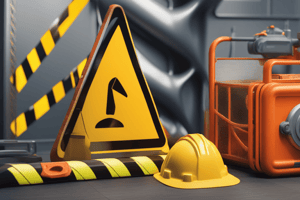Podcast
Questions and Answers
What are safety hazards and risks?
What are safety hazards and risks?
Safety hazards are potential sources of harm or adverse health effects to people, equipment, or the environment, while risks are the likelihood of those hazards causing harm or adverse health effects.
Why is it important to understand safety hazards and risks?
Why is it important to understand safety hazards and risks?
It is important to understand safety hazards and risks to prevent accidents, injuries, and illnesses, and to create a safe and healthy environment for oneself and others.
What are some examples of safety hazards and risks in the workplace?
What are some examples of safety hazards and risks in the workplace?
Examples of safety hazards and risks in the workplace include working at heights, using heavy machinery, exposure to hazardous chemicals, and ergonomic risks from poor posture or repetitive movements.
What are some physical hazards associated with working at heights?
What are some physical hazards associated with working at heights?
What are some physical hazards associated with working in confined spaces or at depths?
What are some physical hazards associated with working in confined spaces or at depths?
How can workers protect themselves from hazards associated with height and depth?
How can workers protect themselves from hazards associated with height and depth?
Flashcards
What are safety hazards?
What are safety hazards?
Potential sources of harm or adverse health effects to people, equipment, or the environment.
What are risks?
What are risks?
The likelihood of hazards causing harm or adverse health effects.
Why understand safety?
Why understand safety?
To prevent accidents, injuries, and illnesses, and to create a safe and healthy environment.
Height hazard examples?
Height hazard examples?
Signup and view all the flashcards
Confined space hazards?
Confined space hazards?
Signup and view all the flashcards
How to protect from height/depth?
How to protect from height/depth?
Signup and view all the flashcards
Study Notes
Safety Hazards and Risks
- Safety hazards refer to potential sources of danger that can cause injuries or harm.
- Risks are the likelihood of experiencing a harmful event as a result of exposure to a hazard.
Importance of Understanding Safety Hazards and Risks
- Awareness helps in preventing accidents and injuries.
- Understanding hazards enables effective planning and implementation of safety measures.
- Promotes a culture of safety within the workplace, enhancing overall well-being.
Examples of Safety Hazards and Risks in the Workplace
- Slips, trips, and falls due to wet floors or uneven surfaces.
- Electrical hazards from exposed wires or faulty equipment.
- Chemical exposure from spills or improper handling of toxic substances.
- Ergonomic risks from repetitive motions or improper lifting techniques.
Physical Hazards Associated with Working at Heights
- Risk of falls from ladders, scaffolding, or roofs.
- Poor weather conditions can compromise stability and increase the risk of accidents.
- Falling objects pose threats to those below, necessitating proper securing and warnings.
Physical Hazards Associated with Working in Confined Spaces or at Depths
- Limited oxygen levels or accumulation of toxic gases can lead to suffocation or poisoning.
- Risk of entrapment or difficulty in evacuation regarding confined space emergencies.
- Increased pressure risks in underwater environments can cause physical harm.
Protection from Hazards Associated with Height and Depth
- Use of personal protective equipment (PPE) such as harnesses, helmets, and lifelines.
- Implementation of safety protocols and training on proper techniques for working at heights or in confined spaces.
- Regular inspections and maintenance of equipment to prevent failure or accidents.
- Establishment of rescue plans and emergency procedures for quick response times in case of incidents.
Studying That Suits You
Use AI to generate personalized quizzes and flashcards to suit your learning preferences.




